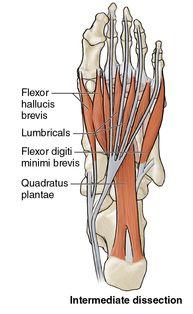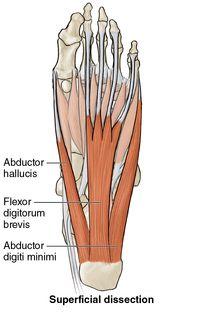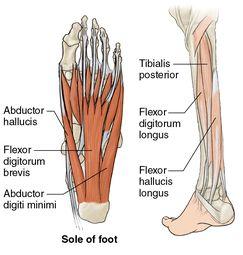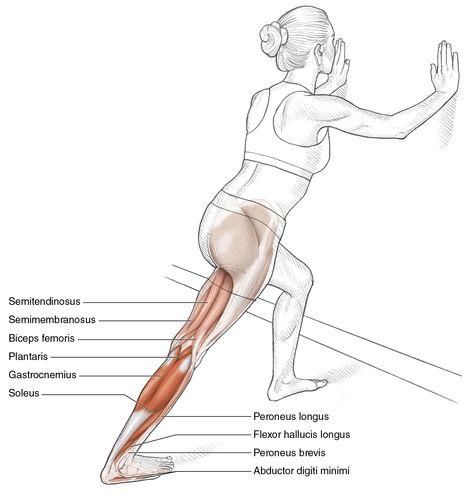Stretching Anatomy-2nd Edition (22 page)
Read Stretching Anatomy-2nd Edition Online
Authors: Arnold Nelson,Jouko Kokkonen
Tags: #Science, #Life Sciences, #Human Anatomy & Physiology

Execution
- While sitting on a chair with the left foot on the floor, raise the right ankle and place it on top of the left knee.
- Brace the right ankle with the right hand, and place the fingers of the left hand along the bottoms of the toes of the right foot, with the fingers pointing in the same direction as the toes.
- Use the fingers of the left hand to push the toes of the right foot toward the right knee.
- Repeat this stretch for the opposite leg.
Muscles Stretched
- Most-stretched muscles:
Right flexor digitorum brevis, right quadratus plantae, right flexor digiti minimi brevis, right flexor hallucis brevis, right lumbricales, right plantar interosseous, right abductor hallucis, right abductor digiti minimi - Less-stretched muscles:
Right flexor digitorum longus, right flexor hallucis longus, right tibialis posterior, right peroneus longus, right peroneus brevis, right plantaris, right soleus, right gastrocnemius
Stretch Notes
The foot muscles located in the arch of the foot receive constant stress during daily activities. The stress comes from supporting body weight during activities such as standing, walking, jumping, and running. Toe muscles also apply force against the ground whenever you are moving. Thus they are in constant use for most of the day, especially if you are an active person. After walking and standing long hours, foot muscles are often more tired, sore, and tight than any other muscle group in the body. You might even experience cramping of these muscles after a long day’s work. Stretching these toe flexor muscles will help reduce the pain and soreness after a hard day’s work and make you feel better. The muscles of the bottom of the foot are quite sensitive and respond to stretching exercises very well. Light massage along with light stretching exercises make you feel pleasantly relaxed after you have been on your feet most of the day.
Make sure to stabilize the foot and ankle with a firm hold. Pushing hard on the very ends of the toes with the left palm will provide a much greater stretch. You will feel the stretch on the sole (plantar side) of the foot.
Advanced Standing Toe Flexor Stretch
Execution
- Stand upright while facing a wall, 1 to 2 feet (30 to 60 cm) away.
- Keeping the heel of the right foot on the floor, press the bottoms of the toes of the right foot up against the wall. The ball of the foot should be more than half an inch (more than 2 cm) above the floor.
- Lean forward and slide the ball of the right foot slowly down, keeping the toes pressed against the wall.
- Repeat this stretch for the opposite leg.
Muscles Stretched
- Most-stretched muscles:
Right flexor digitorum brevis, right quadratus plantae, right flexor digiti minimi brevis, right flexor hallucis brevis, right lumbricales, right plantar interosseous, right abductor hallucis, right abductor digiti minimi - Less-stretched muscles:
Right flexor digitorum longus, right flexor hallucis longus, right tibialis posterior
Stretch Notes
Have you driven a car for many hours without stopping? Have you ever felt that your foot is getting tired of moving the gas pedal up and down or being held in the same place for a long time? It happens to most of us. The muscles of the foot are not used to this. They simply get tired. This stretch or any of the previous stretches would be beneficial during a long drive.
Make sure the ball of the foot is parallel to the floor. This ensures that all the toes are stretched equally. Also, slide the ball of the foot down slowly. Otherwise, overstretching could happen. Bending the right knee slightly and moving the knee forward toward the wall will incorporate the calf muscles in the stretch.
Beginner Plantar Flexor Stretch
Execution
- Stand facing a wall, 2 feet (60 cm) away.
- Brace your hands against the wall.
- Keeping the left foot in place, place the right foot 1 to 2 feet (30 to 60 cm) behind the left foot. The left foot is 1 to 2 feet away from the wall, and the right foot is 2 to 4 feet (60 to 120 cm) away from the wall.
- Keeping the right heel on the floor, lean your chest toward the wall. You can bend the left knee slightly to facilitate moving the chest up against the wall.
- Repeat this stretch for the opposite leg.
Muscles Stretched
- Most-stretched muscles:
Right gastrocnemius, right soleus, right plantaris, right popliteus, right flexor digitorum longus, right flexor hallucis longus, right tibialis posterior - Less-stretched muscles:
Right peroneus longus, right peroneus brevis, right flexor digitorum brevis, right quadratus plantae, right flexor digiti minimi brevis, right flexor hallucis brevis, right abductor digiti minimi, right abductor hallucis, right popliteus, right semitendinosus, right semimembranosus, right biceps femoris
Stretch Notes
Any time you start a new exercise program or participate in unusual or unfamiliar activities, you might experience muscular soreness during the days that follow. This is commonly known as delayed-onset muscle soreness, or DOMS. This painful feeling is felt most often 24 to 72 hours after the exercise. Walking or running uphill or downhill typically produces this painful effect. Calf muscles are usually affected more than any other muscle group in the body. Repeated stretching of these muscles for several days will help relieve the pain of DOMS.
As the chest gets closer to the wall, bending the knee slightly will realign the tibia and increase the distance between the muscle attachment points. This will increase the stretch on the tibialis posterior, flexor hallucis longus, and flexor digitorum longus muscles while at the same time reducing the stretch on the hamstring muscles.
Advanced Plantar Flexor Stretch
Execution
- Stand upright on the edge of a stair or beam, with the midsection of the right foot on the edge. Hold onto a support with at least one hand.
- Keep the right knee straight and the left knee slightly bent.
- Lower the right heel as far as possible.
- Repeat this stretch for the opposite leg.
Muscles Stretched
- Most-stretched muscles:
Right gastrocnemius, right soleus, right plantaris, right popliteus, right flexor digitorum longus, right flexor digitorum brevis, right flexor hallucis longus, right flexor hallucis brevis, right tibialis posterior, right quadratus plantae, right flexor digiti minimi brevis, right abductor digiti minimi, right abductor hallucis - Less-stretched muscles:
Right semitendinosus, right semimembranosus, right biceps femoris
Other books
Zombies Suck by Z Allora
IGMS Issue 32 by IGMS
Breathless by Bonnie Edwards
Weekend Warriors by Fern Michaels
Orfe by Cynthia Voigt
Dangerously Happy by Varian Krylov
The Last Wolf: A Highplains Shifter Erotic Romance (Wolf Fire Book 1) by Alice Longstaff
Doctor Who: Rags by Mick Lewis
El sudario by Leonard Foglia, David Richards
The Messiah of Stockholm by Cynthia Ozick







